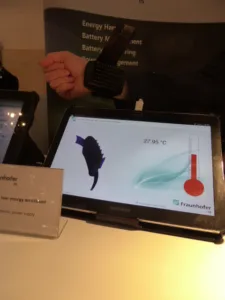DuPont Teijin Films makes the organic films behind the flexible displays from, for instance, FlexEnable. Currently these require conventional (rigid) transistors, as DuPont’s are not ‘smart’ enough to do more than a very basic phase change: for instance, turning a black pixel white in electronic paper. Work is being done on this.
FlexEnable was showing the wrist-worn flexible prototype that it introduced at MWC 2016 (FlexEnable Curves an LCD Around the Wrist).
A very early prototype wristband from Fraunhofer IIS featured an accelerometer, temperature sensor and Bluetooth LE module. It was powered by the temperature differential between the wearer’s skin and ambient temperature, with a component to convert this into usable energy.
Jenax is a South Korean firm producing flexible batteries called J.Flex (Battery Raises Capacity, Withstands 1 Million Folds). These are lithium batteries made using metal fibre, which can be rolled, twisted, scrunched and bent. There doesn’t seem to have been much innovation since we last covered the company in 2015, however: battery sizes and capacities are still the same. Jenax claims that the J.Flex capacity is six times higher than existing batteries for smartwatches, and is suitable for applications such as this by being built into the strap.
The National Graphene Institute is a UK-based organisation, spun out of the University of Manchester. It is focused on helping companies scale up from prototyping to manufacture. Currently, the NGI works with around 60 companies from across the world.
Polar OLED had a very interesting method of creating OLED displays with solution processing. See our separate article for more (Polar OLED Has Solved Printing Problem).
Dutch university TU Delft was showing its solar-powered racing car, the Nuon 7S. It has won a world championship race twice and can reach speeds of 160kmph (although 95-100kmph is when the energy in/out are balanced). Two displays are installed: one for showing stats to the driver and communication with a control car behind, and another as a ‘rear mirror’. Every gram of weight is important in this car, but the screens are LCD – the team had not thought of using OLED! If the car turns up at the next race using OLED, we’re happy to claim credit for that.
Visionect was showing its E Ink signage displays, which use no cables and have a low installation cost. GPS and 3G are integrated to enable remote updates and location information. They have been installed in Houston, Sydney, Singapore and more, and are being trialled at London bus stops now.

